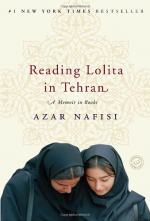
|
| Name: _________________________ | Period: ___________________ |
This test consists of 15 multiple choice questions and 5 short answer questions.
Multiple Choice Questions
1. Why does the male student have to meet with Nafisi separately?
(a) The female students do not like having a male student in their class.
(b) A group with men and women would arouse suspicion from the Islamist authorities.
(c) His schedule does not permit him to meet with the female students.
(d) Nafisi believes that male and female students learn differently.
2. In Chapter 9, what does Nafisi do to answer Yassi's question?
(a) Nafisi tells Yassi that she should not get married while she is young.
(b) Nafisi uses literature as a point of reference for her answer.
(c) Nafisi tells Yassi to ask her parents for assistance.
(d) Nafisi shows Yassi pictures of her childhood.
3. What type of author do the students seem most interested in studying?
(a) "Revolutionary" authors who are tied to current political ideologies.
(b) "Non-revolutionary" authors such as Joyce, Nabokov, Woolf, and Austin.
(c) Authors who have female characters with strong opinions.
(d) Authors who show the benefits of a religious society.
4. Why was Nafisi's father arrested?
(a) He challenged the educational system.
(b) He ignored directions from those in higher levels of government.
(c) He was not a member of the religious community.
(d) He lost a great deal of money and could not pay the bills.
5. What scene opens Chapter 12?
(a) The members of the class arriving at Nafisi's house.
(b) The class sitting around a table in Nafisi's apartment.
(c) Nafisi search for books in a bookstore.
(d) Nafisi teaching a class at the University.
6. What is Nafisi doing at the beginning of Chapter 11?
(a) Looking at the photographs of the girls.
(b) Cleaning out her office at the University of Tehran.
(c) Looking over the class notes she kept from the study sessions.
(d) Remembering her life as a child.
7. What causes Manna and Nima to fall in love?
(a) They see parallels between their lives and the lives of Humbert and Lolita.
(b) They are in the same literature study group.
(c) They share a passion for the revolutionary cause.
(d) They share a common passion for literature.
8. Why is Mashid jailed?
(a) Because she is associated with a dissident organization.
(b) Because she steals flowers.
(c) Because people find out she was studying literature.
(d) Because she tells her parents she was translating Islamic texts into English.
9. What does Nafisi's study group conclude about "Lolita"?
(a) She was the victim of two crimes, losing her life and her own life story.
(b) She was a highly desirable but difficult young woman.
(c) She was not the victim she always claimed to be.
(d) She was a despicable and shallow girl.
10. Nassrin describes herself as being in the middle of what for her whole life?
(a) In the middle of tradition and change.
(b) In the middle of safety and danger.
(c) In the middle of insubordination and obedience.
(d) In the middle of fiction and reality.
11. At the beginning of Chapter 18, what does Nafisi ask the reader to imagine?
(a) They are inside her apartment.
(b) They are walking down a leafy path.
(c) They are standing on a street in Tehran.
(d) They are at the university.
12. What secret does Nassrin tell Nafisi?
(a) She had left her family to work for an Islamist student group.
(b) She had been sexually abused by her youngest uncle.
(c) She was leaving for America.
(d) She had been married and divorced.
13. How do the Iranian authorities view the country's past?
(a) Iran's past is considered important in the development of a perfect Koranic society.
(b) The Iranian leaders see the country's past as an example for other societies.
(c) Iran's past is used as a foundation for the development of a more modern society.
(d) The past is irrelevant to the leaders who want to establish a perfect Koranic society.
14. Who was Nafisi's father?
(a) The youngest mayor of Tehran in pre-revolutionary Iran.
(b) A troubled businessman.
(c) A famous author.
(d) The director of a high school in Switzerland.
15. Where are Nafisi's children when Chapter 19 begins?
(a) Washington.
(b) At a restaurant.
(c) Jail.
(d) Tehran.
Short Answer Questions
1. What does Nafisi see reflected in the mirror?
2. How does Nafisi feel about revealing herself in class?
3. What object becomes popular in Iran?
4. What does Nafisi consider to be the first lesson in democracy?
5. At the beginning of Chapter 16, what are Nafisi and her male acquaintance discussing?
|
This section contains 816 words (approx. 3 pages at 300 words per page) |

|




